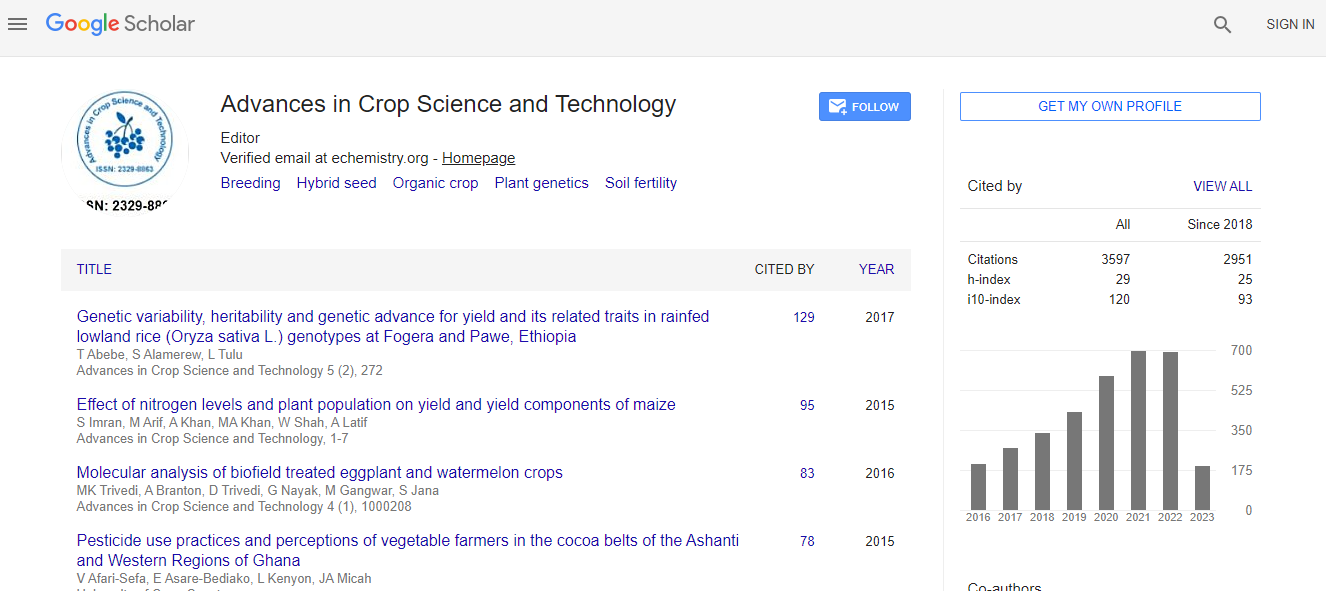Our Group organises 3000+ Global Conferenceseries Events every year across USA, Europe & Asia with support from 1000 more scientific Societies and Publishes 700+ Open Access Journals which contains over 50000 eminent personalities, reputed scientists as editorial board members.
Open Access Journals gaining more Readers and Citations
700 Journals and 15,000,000 Readers Each Journal is getting 25,000+ Readers
Google Scholar citation report
Citations : 5759
Advances in Crop Science and Technology received 5759 citations as per Google Scholar report
Advances in Crop Science and Technology peer review process verified at publons
Indexed In
- CAS Source Index (CASSI)
- Index Copernicus
- Google Scholar
- Sherpa Romeo
- Online Access to Research in the Environment (OARE)
- Open J Gate
- Academic Keys
- JournalTOCs
- Access to Global Online Research in Agriculture (AGORA)
- RefSeek
- Hamdard University
- EBSCO A-Z
- OCLC- WorldCat
- Scholarsteer
- SWB online catalog
- Publons
- Euro Pub
Useful Links
Recommended Journals
Related Subjects
Share This Page
Irri drop report: Framework for quantifying and reporting canal water losses
Global summit on Agriculture & Organic farming
Macdex Mutema
Agricultural Research Council-Natural Resources and Engineering, South Africa
ScientificTracks Abstracts: Adv Crop Sci Tech
Abstract
Canal use for conveying water is as old as irrigation development. Canals remain in use at many irrigation schemes today because they transport bulk water cheaply. However, canals are associated with high water losses through, mainly, seepage, leakage, and evaporation. While the water losses are known to exist, their quantification is a daunting task due to several challenges. Firstly, canal water flow is turbulent and unsteady. Secondly, the canal water losses vary with microclimates, environmental conditions, and physical characteristics of the canal network. Thirdly, separating seepage and leakage in the field cannot be practically done, which makes modeling to understand their character and dynamics as individuals impossible. Yet, it is important to quantify the different canal water loss types at different spatial-temporal scales and to understand their main drivers with a view to generating strategies for corrective measures. As a first step, a literature study was performed to elucidate the effects of canal water flow and soil characteristics on water losses. Data 1388 canal sections from 45 peer reviewed papers published across the world were used, with the results showing that evaporation is generally negligibly smaller than both seepage and leakage losses. The results confirmed that water losses decline with increasing soil clay content regardless of lining material. Canal shape, wetted perimeter and wetted area also showed significant effects on water losses. In addition, methods for assessing the canal water losses had effects on the quantitative values of the losses. The physical mechanisms of the dominant water loss types together with dominant driving factors need to be considered in future field research. The impact of physical features such as embankment height and freeboard depth on water losses also need consideration. The study results, informing on future field research on canal water losses, should excite water scientists, engineers and practitioners.Biography
Macdex Mutema is a Senior Research Engineer at the Agricultural Research Council-Natural Resources and Engineering, South Africa, in the Irrigation and Agricultural Infrastructural Engineering division. He has expertise in assessing the condition and performance of irrigation infrastructure for smallholder and large-scale irrigation systems. The Irri Drop Report is an attempt to develop a framework for capturing and reporting on the major water loss types from irrigation canals in South Africa. The framework aims to eventually evolve into a model that report on the spatial and temporal variability of the different major water loss types for lined and unlined canals, and also for different lining materials and canal shapes. The proposed framework borrows from the Water Use Efficiency Accounting Report (WUEAR) developed for the Water Administration System (Water Admin, https://wateradmin.co.za) developed by NB Systems, who are partners in development of the Irri Drop Report.

 Spanish
Spanish  Chinese
Chinese  Russian
Russian  German
German  French
French  Japanese
Japanese  Portuguese
Portuguese  Hindi
Hindi 
